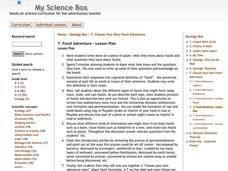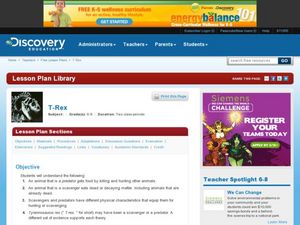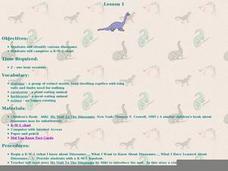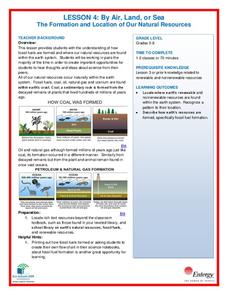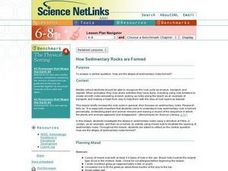Curated OER
What Do We Learn From Fossils?
Students investigate what a fossil is and how it came to be. In this fossil lesson, students examine pictures of skeletons and identify characteristics that can and cannot be determined by a fossil. Students complete diagrams...
Curated OER
Lesson 1 - What Are Fossils?
Students define and research fossils. In this fossil instructional activity, students access teacher assigned Internet sites to examine images of fossils. They determine the definition of a fossil and find out how fossils are formed....
Curated OER
Fossil Adventure
Students create a book about the process of a dinosaur becoming a fossil. In this earth science lesson, students are taught about fossils and create a book that tells what happened to a dinosaur's bones after they die.
Curated OER
Fossil Adventure
Students work as a class to write a general definition of fossil based on their discussion and examine pictures of the different types of fossils. Once discussion is complete, they write and illustrate a book about a T Rex that has died...
Curated OER
T-Rex
Students examine the differences between a scavenger and a predator. In this predator lesson students research an animal and study its physical traits.
Curated OER
CyberHunt: Digging for Dinosaurs
Students discover dinosaur facts using internet research. In this 2nd - 3rd grade lesson plan, students identify various dinosaur facts. Students use internet research to answer questions regarding dinosaurs.
Curated OER
In the Wild
Third graders examine the concept of ecology and how animals are suited to their habitats. For this animal adaptation lesson, 3rd graders identify a variety of plants and animal species that live in a Beech forest.Students create a food...
Curated OER
Identifying Dinosaurs
Students investigate basic information about dinosaurs. They listen to the book, "My Visit To the Dinosaurs," explore various websites, take an online quiz, and play an online dinosaur game.
NOAA
Climate Is Our Friend…Isn’t It?: Make an Extinction Polyhedron
Climate affects populations in different ways. Scholars research extinct organisms and mass extinctions in part three of the 10-installment Discover Your Changing World series. They create graphic organizers, then fill in the...
Curated OER
Creating New Forms of Life
High schoolers are asked to use their imaginations to take the idea of biotechnology one step further. Before beginning this activity students read and complete a report on the book "Jurassic Park," which deals with the use of...
Curated OER
Dino Dung!
Students examine how there is more to poop than they think! After reading through material, they answer a series of questions on coprolite, and explore the diet and physical attributes of dinosaurs, as well as their environment.
Curated OER
Plants of the Past
Fourth graders explore ecosystems by examining plants of the past. They discuss ways in which we interact with plants in our daily lives. Students discuss the role plants play in providing food for animals and the significance they had...
National Wildlife Federation
By Air, Land, or Sea: The Formation and Location of Our Natural Resources
Coal forms from the ancient remains of plants that were alive on Earth before the dinosaurs! Scholars use their t-charts from the previous lesson over resources and research to determine if their information is correct. Through analysis...
Curated OER
How Sedimentary Rocks are Formed
Students investigate the stripes in sedimentary rocks, using a structure at Petra, Jordan, as an example, and then do a hands-on activity using mixed nuts to illustrate the layering of sedimentary rocks.
Curated OER
Earth Epochs
Students explore earth epochs, i.e, Permian, Precambrian, Cambrian, Ordivician and through pictures they see what life on Earth and animals looked like. They organize Earth Epochs according to years going from greatest to least...
Curated OER
The Energy Debate - Conclusion
Young scholars write a persuasive essay about the choices in the energy debate. They comprehend the environmental consequences that accompany the decision. Students predict how they will power their future.


